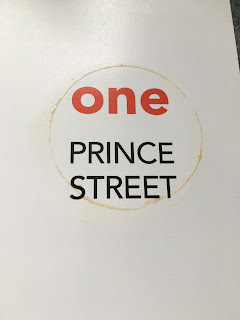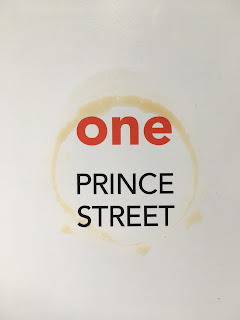Trackside Treasure
Friday, April 26, 2024
Early-era VIA in Kingston: 1976-1977 and More!
Thursday, April 18, 2024
Chris Mears' Magazine One
Can you expect a Trackside Treasure post every time I get something new to read? Of course not! But this was not just something new. This was the first printed prodigious product of Prince Street blog partner Chris Mears' mind. So it does warrant its own post. Dash 9's disappeared, damned to Draft status.
- no author on cover - oh here, let me take obvious credit for what I've done to get my name in print. Not here. Not needed. Let the title speak for itself.
- always comparing - why was I reading One thinking I would have done this or that different? Go get your attitude of gratitude and use it, self.
- just be different - how can I infer and interpret everything Chris thinks? Just enjoy the fruits of his beard-bemused labours.
- Zinger Egg - not an Easter Egg, better. Nearly every page has a thought explosion that goes ballistic then shrieks in and embeds itself in the reader's brain. Or so it should. I photographed some (below). Now where was I...
- ah yes - colour and illustrations. High quality presentation and content everywhere.
- show your work - they told us in math class. Isn't getting the right answer enough? No, how did you get here from there. Chris unabashedly does this, whether the process is dirty, clean, or in many cases granular and gritty.
- I would never think of this stuff in this manner - we all have different brains. Why does the MR press make modellers pigeon-hole their layouts and their process under tidy subtitles?
- granular detail - the text is data-packed, with in-process photos, drawings and facts all arranged. Sometimes showing actual granules!
- think, then do - the MR press leaves us hanging with nonsensical author quotes like, "I haven't thought about operations, even though my layout is nearly complete." Whaaaa?
Friday, April 12, 2024
Railfans don't age - we just lose track of each other
Running extra...
 I'm so proud to share in fellow blogger Chris Mears' success elation at the publication of his first magazine ONE. To quote Chris, "Making One was not a copy-paste job. The magazine is filled with new drawings, new words. I loved making this art so much and that alone powered me through so many moments where I wanted to 'not do this anymore'....Prince Street has existed for fifteen years and feels, at times, like it has its own character. That said, holding onto One is exactly what I wanted it to feel like: offline, released from under glass. There is nothing like the feel of paper. I love it."
I'm so proud to share in fellow blogger Chris Mears' success elation at the publication of his first magazine ONE. To quote Chris, "Making One was not a copy-paste job. The magazine is filled with new drawings, new words. I loved making this art so much and that alone powered me through so many moments where I wanted to 'not do this anymore'....Prince Street has existed for fifteen years and feels, at times, like it has its own character. That said, holding onto One is exactly what I wanted it to feel like: offline, released from under glass. There is nothing like the feel of paper. I love it."
Chris was kind enough to let me know my copy is already on its way. I believe strongly in encouraging and supporting each other as we rubber ball-bounce around the boundless blogosphere. It's great to see Chris busting out of the blogosphere into new media like video and publishing. That moment he experienced took me back to seeing the first draft of my VIA Rail book on a work computer, sent to me by my graphic designer Bryan Babcock. It's a given that Chris has put a lot of thought into everything he does. It's so nice to see something than the usual rota of MR press articles: Concept, Benchwork, Wiring, blah-blah-blah-boring. I heartily hope you'll check out Chris' work.
I know that Chris values having things to look at in our hands. He's announced that the first print run has already sold out! So I can't wait to get my hands on his magazine and I'm looking very much forward to TWENTY-SEVEN. No pressure, Chris!
Saturday, April 6, 2024
Kingston & Pembroke Stations
 |
| Glenvale |
| Murvale in October, 1970 (Queen's University Archives, George Lilley Fonds, V25.5-39-108) |
 |
| Harrowsmith, 1960 |
 |
| Hartington, 1948 (Queen's University Archives, George Lilley Aerial Photographs, V25.6-1-6-35) |
 |
| Verona in October, 1970 (Queen's University Archives, George Lilley Fonds, V25.5-39-109) |
 |
| Godfrey, undated |
.bmp)

.bmp)

















































